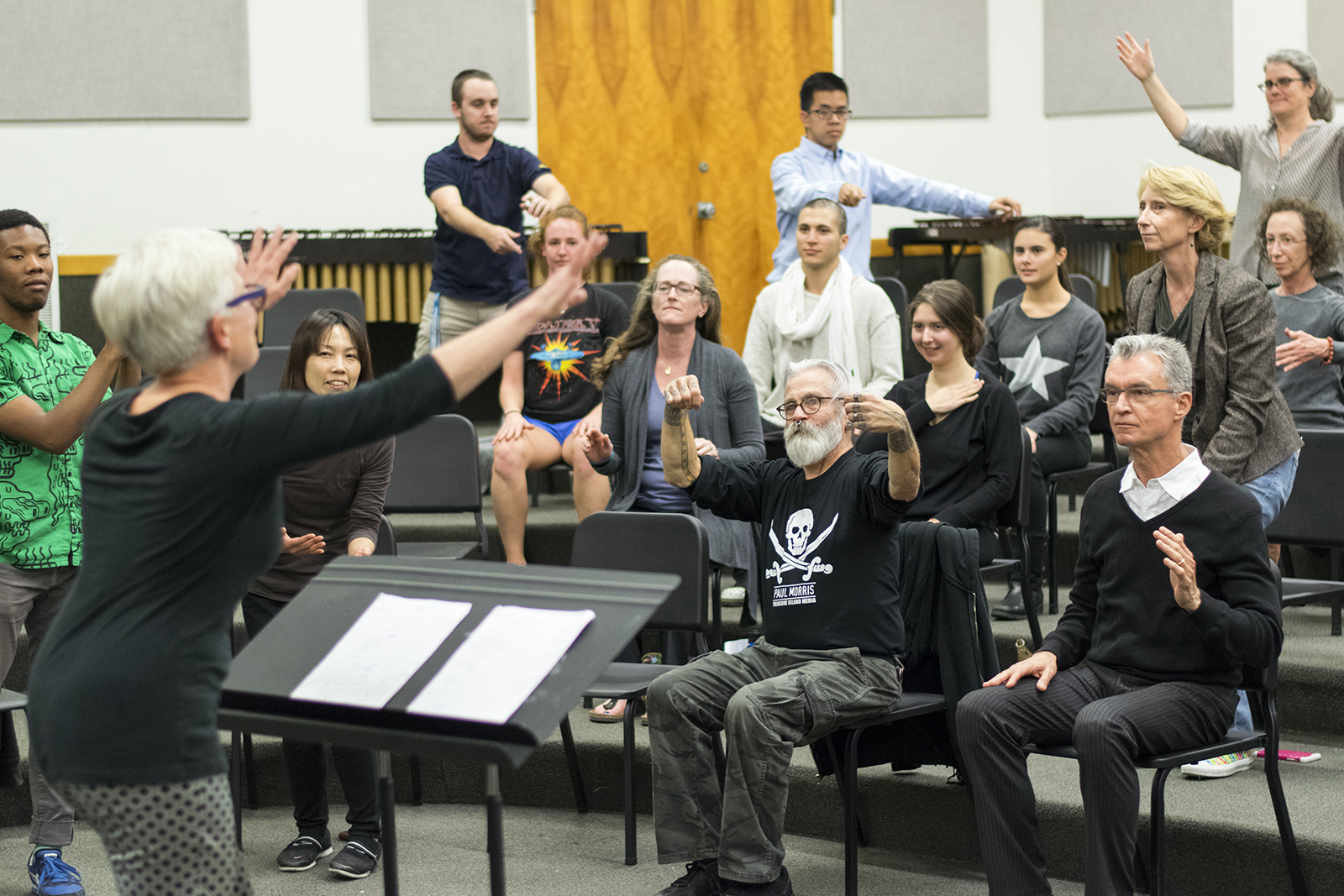Artist portrays everyday movements in ‘The Symphonic Body’

UCLA maintenance workers, athletes, students and professors will perform in artist-in-residence Ann Carlson’s “The Symphonic Body,” a movement-based piece. (Michael Zshornack/Daily Bruin)
By Kayla Hausmann
Nov. 20, 2015 12:23 a.m.
Two women begin to dance. One sways her arms above her head while the second turns sideways in her chair, twirling her wrists in tight circles.
The two women are UCLA custodians, and the choreography for their dance was inspired by years of scrubbing toilet bowls and wiping windows, of replacing trash bags and cleaning sinks.
They will join a group of other maintenance workers, athletes, students and professors in Ann Carlson’s “The Symphonic Body,” which opens at Royce Hall on Saturday.
In Carlson’s orchestral work, members of the UCLA community perform gestures from their work day, rather than playing instruments, in a roughly 45-minute choreographed piece. While it is not accompanied by a soundtrack, Carlson said she sees the performance as physicalized music, a social sculpture that provides a window for the labor and energy of UCLA.
Carlson said that much of her work since the ’80s has revolved around people with a shared passion. After creating a series of works based off the principle of community, including pieces about lawyers, nuns and fly fishermen, she said the next logical step was “The Symphonic Body.”
“I love going and talking to people and observing their work gesture, observing the impact of work or their passion,” Carlson said.
As an artist-in-resident, Carlson began work for “The Symphonic Body” at UCLA with Meryl Friedman, director of education and special initiatives at the Center for the Art of Performance at UCLA, or CAP.
Carlson observed and recorded the gestures Friedman used in her daily life, choreographing these movements into a series of actions, which she calls a portrait. Friedman’s portrait includes gestures as simple as crossing her legs to dramatically rotating her body around to peer behind her.
“(A portrait) brings movements that you didn’t know you had,” Carlson said. “The exchange of (the portrait) is kind of vulnerable and very intimate in a way, but then it gradually becomes this other thing, this unwitting dance.”
After completing the portrait with different movements, Carlson asked Friedman for a list of six people at UCLA who inspire her. Carlson approached these six with the idea of “Symphonic Body,” going on to ask each for six more inspirational figures. She eventually gathered a community of members, from student-athletes to the vice chancellor of finance. Carlson worked with each participant, creating individual portraits for just under 100 performers.
Carlson said the diversity of participants in “Symphonic Body” critiques the hierarchy of labor. Some labor, such as that of an administrative figure who gives speeches, is more visible than others, and Carlson said she feels it is important for the audience to acknowledge work that often goes unseen.
Maria Juarez, a UCLA maintenance worker participating in the piece, performs a movement where she sways her arms back and forth over her head. She said this comes from wiping chalkboards and windows – work not noticed as much as a professor lecturing or athletes competing.
Carlson has been rehearsing with the performers since January to refine their choreography. Because the performance is not set to music, she designed a guide detailing when participants are to perform their portraits.
“Frankly, watching other people’s portraits are very inspiring and super moving to me,” Friedman said. “It’s very humbling to see people who are stepping out of their imagined comfort zones but trusting somehow in themselves and in (Carlson) and the process to do it.”
Carlson chose to imitate the symphonic organization by seating her performers in different-tiered semicircles facing the conductor. Grounding the audience, she said this familiar structure keeps the performance from becoming overwhelming.
Davia Schendel, a second-year theater student and performer, began working with Carlson in April. Schendel said many of her movements are taken from her theater classes. In one of her favorite gestures, she peers at the ceiling, a movement she uses to look at someone above her. She said the movement represents her effort to see beyond and connect with someone who is far away.
Schendel said Carlson’s piece depicts how every kind of work contributes to the campus and brings together those whose jobs create UCLA’s atmosphere.
“That’s the most rewarding part … to feel this sense of equality because we all have a purpose on this campus,” Schendel said. “Its really humbling in a beautiful way.”
Carlson said she hopes the audience will find the beauty and dance in ordinary motions performed every day, from restlessly shifting in a chair to tucking a strand of hair behind an ear.
“We have all of these far-reaching and close and exact and big moments that are represented; I use that word to say they are symbolic,” Carlson said. “They’re being performed but they also have this integrity and symbolic life too.”


